181
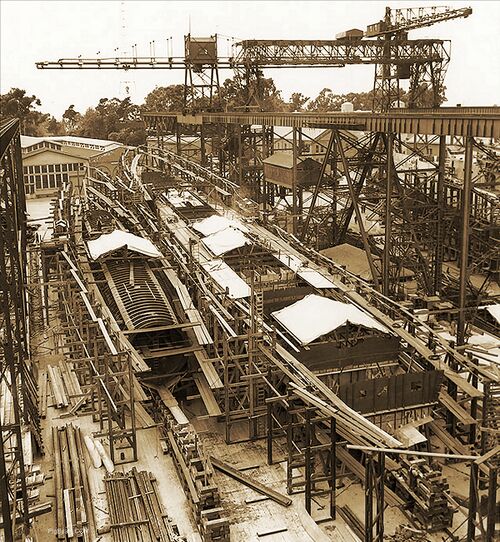
The Henley has her own fantastic war story. When the Japanese attacked Pearl Harbor on December 7, 1941, Henley was moored in East Loch with battle stations manned, a green sailor having sounded General Quarters instead of Quarters for Muster. This fortunate mistake gave Henley the opportunity to fire the first destroyer shots as the initial wave of enemy planes swooped in.
Conned by a junior Lieutenant, Francis Edward Fleck, Jr., (both her commanding officer and executive officer were ashore when the attack began), a bomb exploded 130 yards off her port bow as she slipped her chain from the buoy. As she cleared, she received a signal that a submarine was in the harbor. Henley maneuvered through the smoke, fire, and confusion and sped out of the channel. Her gunners splashed one dive bomber with her .50 cal. guns and shared credit for another. Henley dropped depth charges on a sonar contact, possibly a midget submarine, outside the harbor, and continued to blaze away at the enemy with her guns.
The fighting Henley was finally sunk on October 2, 1943 by a Japanese submarine off Finschafen, New Guinea. She evaded two torpedoes but a third broke her back and she sank at about 6:29 PM (1829) with the loss of 15 crew, 14 enlisted and one officer. 225 were rescued.
U.S. Navy photo.
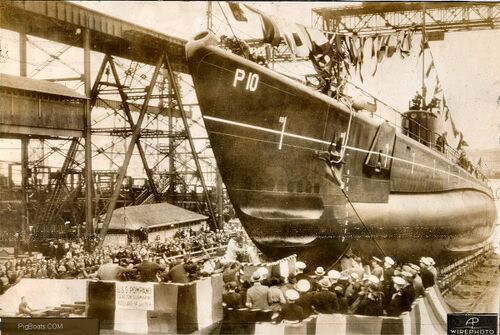
Pompano ready for launch, March 11, 1937 at the Mare Island Navy Yard, California. The class identifier "P10" is prominent on her bow. Officers are on the sub's bridge, a few crew and workmen are on the aft deck. All that is needed is the champagne broken over the bow to start her trip down the ways. Seen just to the left of the bottom torpedo tubes is the ship's sponsor, Mrs. Isaac I. Yates, swinging the champagne bottle on the subs bow. In the photo's left center foreground are three news reel photographers behind their cameras.
U.S. Navy photo, a copy is in the private collection of Ric Hedman.

Pompano on San Francisco Bay circa 1937, perhaps conducting sea trials. She is in her "as built" configuration with her 3"/50 caliber Mk 6 gun mounted aft and a pedestal mounting forward for a Browning M2 .50 caliber machine gun. She also still has both her port and starboard anchors. Later in the war boats with two anchors will have one removed. Pompano was suffering from severe engine problems with her HOR 89DA engines at this point. It would take over eight months of rework to get them into some semblance of proper working order.
U.S. Navy photo.

Pompano underway in the Napa River with the city of Vallejo, CA. in the background, August 19, 1939. She is passing Standard Oil Company buildings on the waterfront. Seen in the background on the hilltop is the Hotel Georgian. Continued issues with her engines kept Pompano homeported at Mare Island for over two years after her commissioning, although she did make a voyage to Hawaii and American Samoa in 1940. She was in transit to Pearl Harbor and just off Oahu on the morning of December 7, 1941.
AP Wire photo in the private collection of Ric Hedman.
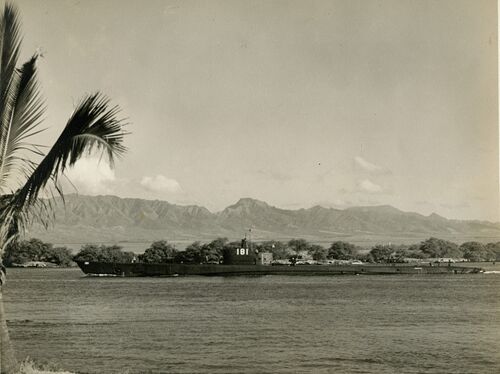
Pompano leaving Pearl Harbor in 1940. This is the main channel just off Hospital Point, with the Waipio Peninsula in the immediate background. She is likely headed for her port visit in American Samoa (see below).
U.S. Navy photo, courtesy of the Digital Collections of the National WWII Museum.
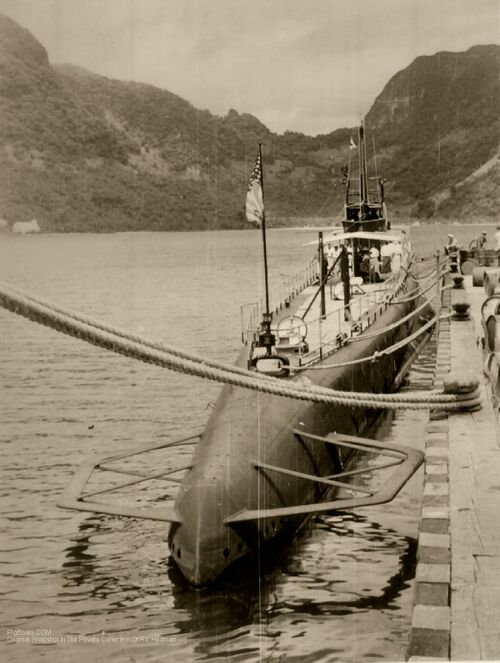
Pompano alongside the pier in 1940 in Pago Pago Harbor, American Samoa. The view is looking across the harbor to the north and the landmark Rainmaker Mountain is seen to the right in the photo. The pier is probably in an area named Fatagoto which is near the Customs House pier and fuel storage docks. A church can be seen on the far shore just at the waterline.
The photo is taken from a spot near a larger vessel moored aft of the Pompano. The crew have rigged an awning on the aft deck to shield from the daytime sun. The pennant flying from the signal mast is the Third Substitute pennant meaning "absence of commanding officer". This indicates that the captain, LCDR Lewis S. Parks has gone ashore. The Governor's Mansion is only a short distance from this dock and Parks is likely making a courtesy visit to the Governor.
Photo in the private collection of Ric Hedman.
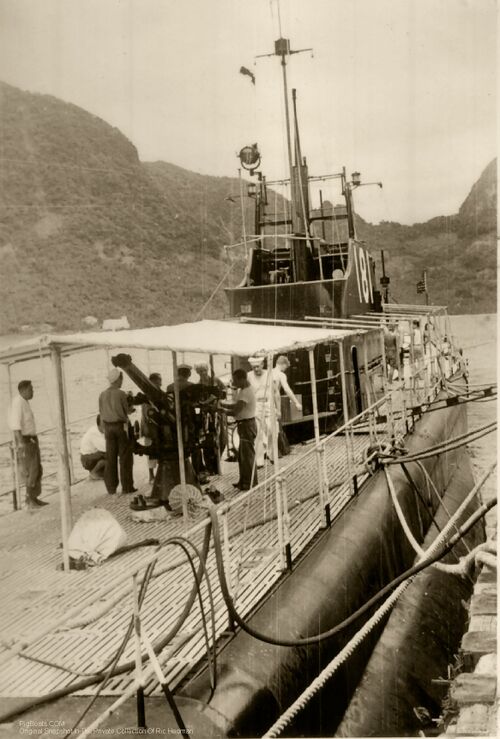
A second photo in the Pompano Samoa visit, showing details of the aft deck and the gun. It looks as if the crew is performing maintenance on the gun. Even though air conditioning was now common equipment on submarines, boats in tropical locations during peacetime still frequently rigged awnings to shade the boat as much as possible from the omnipresent sunshine. Framework for additional awnings have been rigged around the fairwater. In the left foreground note that Pompano's teak slatted deck does not extend all the way to the stern. The remainder of the aft deck is steel plate.
Photo in the private collection of Ric Hedman.

An overhead view of Pompano at the Mare Island Navy Yard, December 24, 1942 during her first wartime overhaul. Massive wartime funding gave the Navy the ability to remove the heavily despised HOR engines and replace them with four hardy and rugged Fairbanks-Morse 38D8⅛ engines that served the boat well for the remainder of her life. Her 3"/50 caliber gun has been moved to the forward position.
Her conning tower fairwater has been heavily modified by cutting away the forward pilothouse and the bulwark around the aft cigarette deck. 20 mm anti-aircraft guns have been placed there on the early solid base Mk 5 mounts. SD air search radar has been added on an extendable mast on the forward fairwater gun deck, in very close proximity to the 20 mm gun mount. SJ surface search radar has been added to the starboard side of the periscope shears. It was put there as opposed to the more common position forward of the periscopes because it would be in the way of the shorter #1 scope, fully raised in this view. This side mount was common on the Porpoise and Salmon/Sargo-class boats. To the left of the shears is the square shaped LF radio loop antenna that enabled communications even when the boat was submerged at periscope depth. Just aft of the shears between the 20 mm mount is a pedestal for a Target Bearing Transmitter, used in night surface attacks. The location of these TBT's varied greatly from boat to boat, reflecting the differing tactical opinions of each boat's crew.
On either side of the deck gun are the boat shaped hatches for motor launches that were formerly carried below the main deck. In the pre-war period these were used to get around in ports with no accommodation for pier mooring. The boats were removed as frivolous luxuries when the war started. The hatches remained.
U.S. Navy photo.
Page created by:
Ric Hedman & David Johnston
1999 - 2023 - PigBoats.COM©
Mountlake Terrace, WA, Norfolk, VA
webmaster at pigboats dot com
